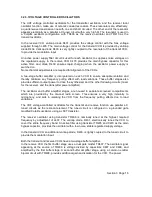
Scan
Button Chevron
LCD 1 is electrically connected to the driver integrated circuit IC 100 by a zebra strip. This IC
contains an internal clock with the frequency set by resistor R104 and capacitor C100. This
clock provides the strobe for the backplane of the LCD.Display information is programmed into
the driver IC from the control microprocessor. The information is programmed serially with the
enable input at PIN 28 of IC held high during the data burst. The information is latched within
IC100.
Backlighting of the LCD is provided by a single incandescent bulb LP101, which is illuminated
when the transceiver is switched on.
The 9-channel front panel has four push buttons which are arranged in a matrix configuration
and connected to the microprocessor via four inputs.
3.2.5.2
64-CHANNEL FRONT PANEL
The visual information is displayed on the Liquid Crystal Display LCD 1. The two seven-
segment symbols provided display up to channel number 64. An additional two seven-
segment symbols are provided to display up to status number 99 for selective call signalling.
Other visual indicators provided are as follows:
Receiver Busy
Transmit
Selcall (call or called)
Scan
Auxiliary 1
Auxiliary 2
Button Chevron
LCD 1 is electrically connected to the driver integrated circuit IC 100 by a zebra strip. This IC
contains an internal clock with frequency set by resistor R 104 and capacitor C 100. This clock
provides the strobe for driving the backplane of the LCD.
Display information is programmed into the driver IC from the control microprocessor. The
information is programmed serially, with the enable input at PIN 28 of IC 100 held high during
the data burst. The information is latched within IC100.
Backlighting of the LCD is provided by two incandescent bulbs LP101 and LP102, which are
illuminated continuously when the transceiver is switched on.
The 64-channel front panel has eight push-buttons which are arranged in a matrix
configuration and connected to the microprocessor via six inputs.
3.2.5.3 KEYBOARD
The keyboard of the 9-and 64-channel variants use a similar matrix. In the 9-channel variant
only 4 positions are scanned whereas in the 64-channel variant the 9 positions are scanned.
Section 3 Page 27
















































